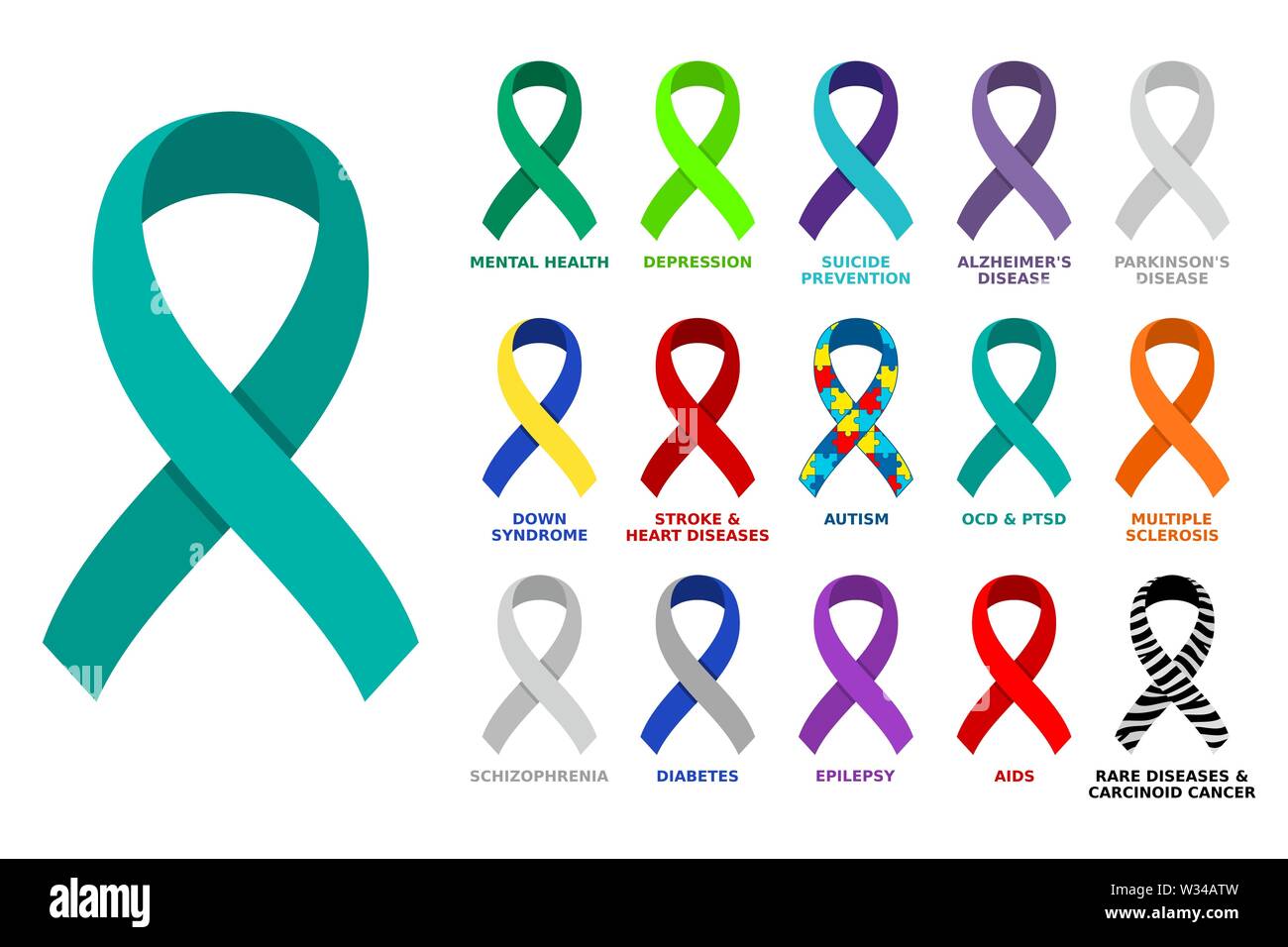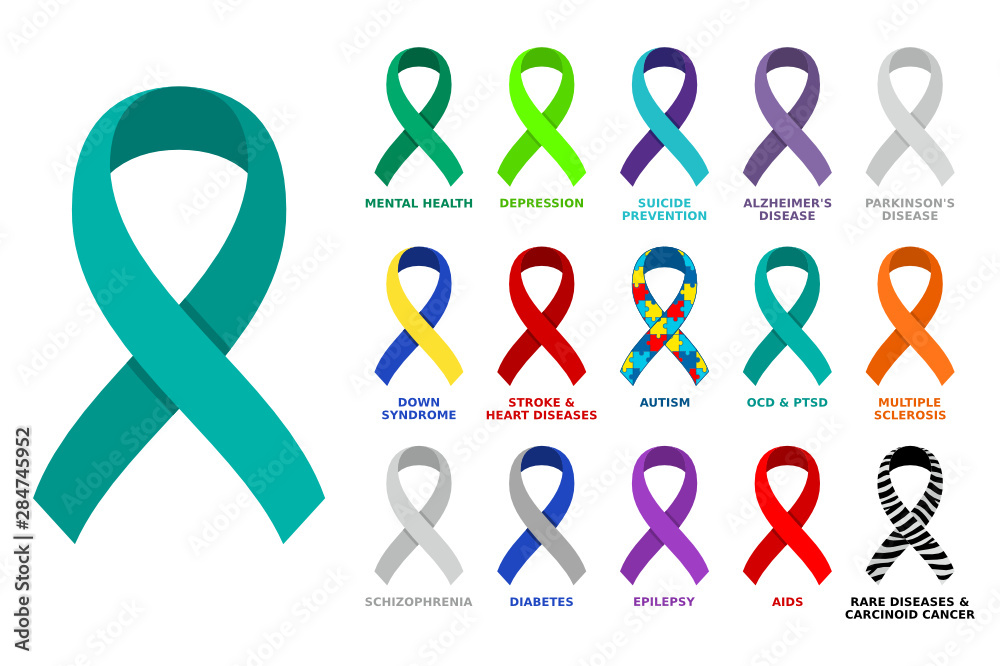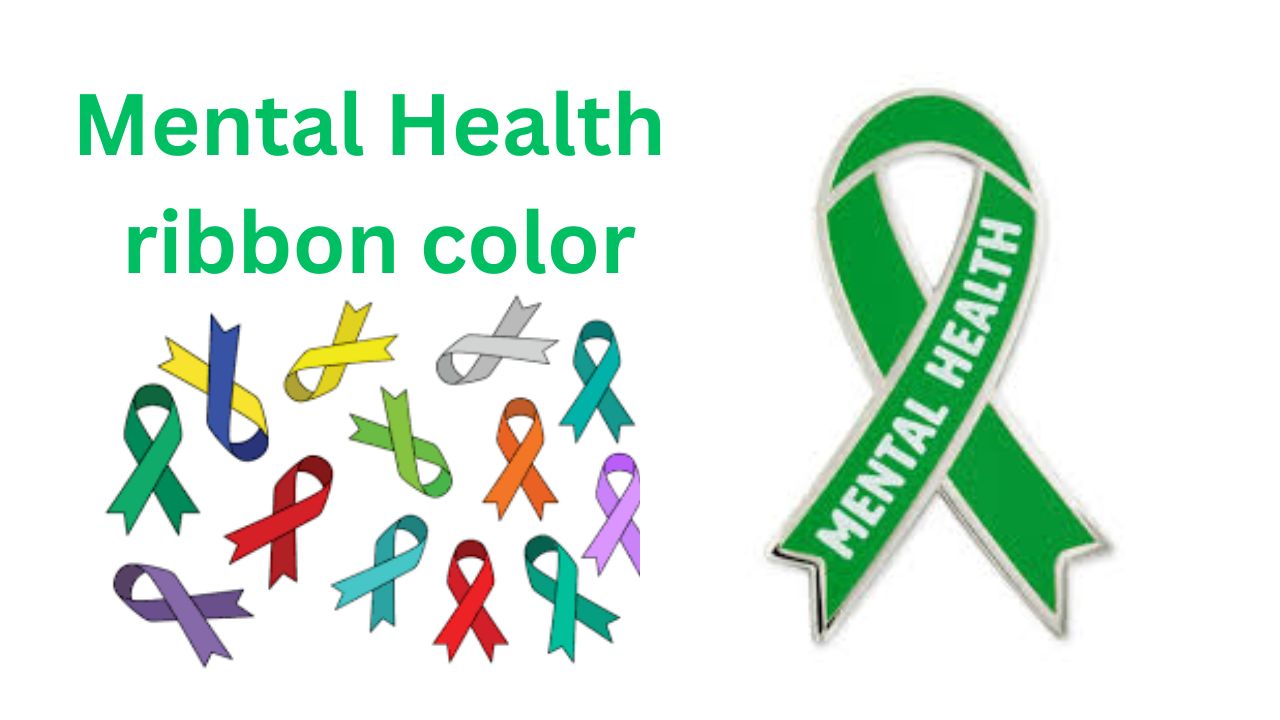The mental health ribbon color is green. It symbolizes mental health awareness and support.
Raising awareness about mental health is crucial for breaking stigmas and promoting understanding and acceptance. The green ribbon serves as a reminder to prioritize mental well-being and support those facing mental health challenges. Individuals show solidarity and advocacy for mental health issues by wearing or displaying the green ribbon.
This simple gesture can spark meaningful conversations and encourage individuals to seek help when needed. Embracing the green ribbon as a symbol of mental health awareness creates a more compassionate and supportive society. Let’s continue to spread awareness and support for mental health initiatives, one green ribbon at a time.

Credit: www.alamy.com
The Symbolism Of Ribbon Colors
Mental health is a critical aspect of overall well-being. Mental health ribbon colors have been used as a symbol to raise awareness about mental health issues and show support for those affected by them. Mental health ribbon colors are a way to communicate a message without saying a word.
Cultural Significance Of Ribbons
Ribbons are integral to many cultures, and their significance varies from culture to culture. In some cultures, ribbons signify essential events such as weddings; in others, they express mourning or grief. The use of ribbons as a symbol of support for those affected by mental health issues is a recent development, but it has quickly gained widespread acceptance.
Ribbon Colors And Their Causes
The color of the ribbon used to represent mental health issues is significant. Each color represents a specific cause, and understanding the meaning behind the color is essential in raising awareness and showing support. Here are some of the most commonly used mental health ribbon colors and their causes:
| Ribbon Color | Cause |
|---|---|
| Green Ribbon | Anxiety disorders, bipolar disorder, depression, and other mental illnesses |
| Silver Ribbon | Eating disorders, Parkinson’s disease, and other neurological disorders |
| Orange Ribbon | ADHD, kidney cancer, and other health issues |
| Yellow Ribbon | Support for troops, suicide prevention, and other causes |
When it comes to mental health, raising awareness and showing support is crucial. Mental health ribbon colors are an easy and effective way to do just that. By understanding the symbolism of ribbon colors, we can show support for those affected by mental health issues and help break the stigma associated with mental illness.
Mental Health Ribbon: A History
The Mental Health Ribbon carries significant symbolism in raising awareness and supporting mental health challenges. Let’s delve into the history of the Mental Health Ribbon, exploring its origins and the evolving perceptions surrounding mental health.
Origins Of The Mental Health Ribbon
The Mental Health Ribbon, often colored green, originated in the early 1990s as a symbol of solidarity and support for individuals facing mental health issues. It was a way to destigmatize mental health struggles and encourage open conversations about mental well-being.
Evolving Perceptions Of Mental Health
Over time, the perception of mental health has shifted towards greater acceptance and understanding. The Mental Health Ribbon has played a crucial role in challenging stereotypes and promoting empathy towards those dealing with mental health conditions.
Green Ribbon: A Beacon Of Hope
Choosing Green: What It Represents
The green ribbon is a symbol of mental health awareness and represents hope, support, and solidarity for those living with mental health conditions. The color green is associated with growth, renewal, and harmony, reflecting the journey of healing and recovery for individuals facing mental health challenges.
Green Ribbon In Public Awareness Campaigns
The green ribbon has been prominently featured in public awareness campaigns to raise awareness about mental health issues and combat the stigma surrounding mental illness. It serves as a visible reminder to promote open conversations and support for those in need.

Credit: stock.adobe.com
The Impact Of The Mental Health Ribbon
The Impact of the Mental Health Ribbon extends beyond its visual representation. By raising awareness and stimulating conversations, the ribbon color is a powerful symbol in the mental health community. Let’s explore the significance of this emblem and how it’s catalyzing positive change.
Spreading Awareness Through Imagery
The Mental Health Ribbon, often in a calming green color, is a visual cue to promote awareness and understanding. When individuals see this ribbon, they are reminded of the importance of mental health and the need to support those affected. The simple yet impactful imagery of the ribbon contributes to breaking the stigma surrounding mental health challenges.
Stimulating Conversations Around Mental Health
The Mental Health Ribbon sparks discussions about mental well-being and encourages individuals to share their experiences. This simple symbol acts as a conversation starter, prompting open dialogues that promote empathy and understanding. By initiating these conversations, the ribbon color is crucial in fostering a supportive and inclusive environment for those facing mental health struggles.
Mental Health Advocacy And The Ribbon
Mental health advocacy has been an increasingly important topic in recent years, with efforts to raise awareness and support for those struggling with mental health issues. Using a ribbon as a symbol for mental health awareness has gained traction, with various colors representing different aspects of mental health. Understanding the significance of the mental health ribbon color and the organizations behind it can help shed light on the importance of advocacy and support for individuals facing mental health challenges.
Organizations Behind The Ribbon
Several organizations have played a pivotal role in promoting mental health awareness through ribbons. These include:
- National Alliance on Mental Illness (NAMI)
- Mental Health America (MHA)
- Depression and Bipolar Support Alliance (DBSA)
Campaigns And Initiatives
These organizations have launched various campaigns and initiatives to promote the mental health ribbon color and its significance. They have worked tirelessly to spread awareness, provide resources, and offer support to those affected by mental health conditions. These efforts have helped destigmatize mental health issues and foster a more supportive and understanding community.

Credit: www.freepik.com
Personal Stories And The Green Ribbon
Testimonials Of Hope And Recovery
Living with a mental health condition can be a challenging journey, but the green ribbon has become a powerful symbol of hope and resilience for many individuals. Here are some inspiring testimonials that shed light on the significance of the green ribbon in personal stories of hope and recovery:
- Emily’s Story: “The green ribbon serves as a beacon of hope for others who may be struggling, as well as a reminder of my own strength.” It’s a symbol of solidarity and a constant reminder that recovery is possible.”
- Jacob’s Journey: “During my journey towards mental wellness, the green ribbon has been my source of courage. It symbolizes growth, renewal, and the unwavering support of my loved ones. It’s a small yet mighty emblem that carries a profound message of resilience.”
The Ribbon As A Personal Symbol
For many individuals, the green ribbon transcends its physical form and becomes a deeply personal symbol of strength, perseverance, and advocacy. Here’s how the green ribbon has evolved into a powerful personal emblem:
- Symbol of Strength: The green ribbon constantly reminds one of one’s inner resilience and determination to overcome mental health challenges.
- Expression of Advocacy: Many individuals proudly wear the green ribbon as a sign of their commitment to raising awareness and eradicating mental health stigma.
Challenges And Criticisms
The mental health ribbon color has faced challenges and criticisms regarding its effectiveness in raising awareness and support for mental health issues. Some argue that it oversimplifies the complexity of mental health struggles, while others believe it lacks specificity for different conditions and experiences.
Despite these criticisms, the ribbon symbolizes solidarity and support for mental health advocacy.
The Commercialization Of Awareness Symbols
The use of mental health ribbon colors has garnered both support and criticism. The commercialization of awareness symbols has raised concerns about the exploitation and dilution of the cause. Some argue that profiting from these symbols may divert attention from the real issues.
Ensuring Sustained Impact Beyond The Ribbon
Ensuring that the awareness campaign goes beyond just wearing a ribbon is essential. Educating people about mental health and providing resources is crucial for sustained impact. Encouraging conversations and destigmatizing mental health is key to creating lasting change.
Expanding The Conversation
Join the conversation on mental health awareness by exploring the significance of the mental health ribbon color. Understanding the symbolism behind this ribbon promotes dialogue and support for those struggling with mental health challenges. Let’s embrace the opportunity to expand awareness and show compassion.
Beyond The Ribbon: Actionable Steps
Mental health awareness is not limited to just wearing a ribbon of a specific color. It is a topic that requires continuous conversation and action. Recognizing mental health’s significance and taking actionable steps toward improving it is essential. Here are some steps that we can take:
- Recognize the Signs: Educate yourself on the signs and symptoms of mental health conditions and encourage others to do the same. This knowledge can help you identify when someone is struggling with their mental health.
- Start a Conversation: Be open to discussing mental health with others and create a safe space for them to share their experiences. This can motivate people to seek care and lessen the stigma associated with mental health.
- Support Mental Health Organizations: Donate to or volunteer with organizations that work towards improving mental health. This can help provide resources and support to those who need it.
- Practice Self-Care: Take care of your mental health by practicing self-care activities such as exercise, meditation, or spending time in nature.
Collaborations For Broader Impact
Collaborating with others is one of the best ways to create a broader impact on mental health awareness. Here are some ways to collaborate for a broader impact:
- Partner with Mental Health Organizations: Partner with organizations that work towards improving mental health to expand the reach of your efforts.
- Collaborate with Influencers: Collaborate with influencers or individuals who have a large following to spread awareness about mental health.
- Join Community Groups: Join community groups focusing on mental health to connect with others who share the same passion.
- Host Events: Host events such as mental health workshops or panel discussions to unite people and create a space for open conversation about mental health.
Expanding the conversation about mental health goes beyond just wearing a ribbon. It requires continuous conversation, actionable steps, and collaboration with others. By taking these steps, we can improve mental health awareness and reduce the stigma surrounding it.
Resources And Support
Discover the symbolic meaning behind the mental health ribbon color and find resources and support for individuals facing mental health challenges. Embrace awareness and solidarity through the powerful message the mental health ribbon color conveys.
Finding Help: A Guide
Mental health issues can be challenging, but you are not alone. Here is a guide to finding the help you need:
- Therapy: Seek professional help from a therapist or counselor.
- Support Groups: Join groups where you can connect with others facing similar challenges.
- Hotlines: Access helplines for immediate support and guidance.
Support Networks And Communities
Building a support network is crucial for mental well-being. Consider these options:
- Online Forums: Participate in forums to share experiences and receive advice.
- Social Media: Connect with mental health advocates and organizations for resources.
- Local Support Groups: Attend in-person meetings for face-to-face support.
Frequently Asked Questions
Why Is Green The Color For Mental Health?
Green is the color for mental health because it symbolizes growth, harmony, and renewal. It’s calming and soothing, representing hope and healing. Green is also associated with nature, promoting balance and well-being.
What Do Different Ribbon Colors Mean?
Different ribbon colors symbolize various causes, like red for AIDS awareness and pink for breast cancer support.
What Does A Teal Ribbon Stand For?
A teal ribbon represents awareness for several health issues, including ovarian, cervical, and uterine cancers, as well as sexual assault and PTSD. It also symbolizes support for caregivers of those with these conditions.
Why Wear A Green Ribbon For Mental Health?
A green ribbon for mental health raises awareness and supports cognitive health initiatives.
Conclusion
Mental health ribbon colors are crucial in raising awareness and support for various mental health conditions. By understanding the significance of each color, individuals can show solidarity and promote understanding. It’s essential to continue the conversation and support those affected by mental health challenges.
Let’s stand together in support and advocacy.

Hello there! I’m here to assist you with health tips and tricks. Whether you’re looking to boost your energy, improve your sleep, or enhance your overall well-being, I’m here to guide you with strategies and frameworks that can empower you to make positive changes.
First and foremost, it’s important to understand that health is a holistic concept encompassing various aspects of physical, mental, and emotional well-being.

